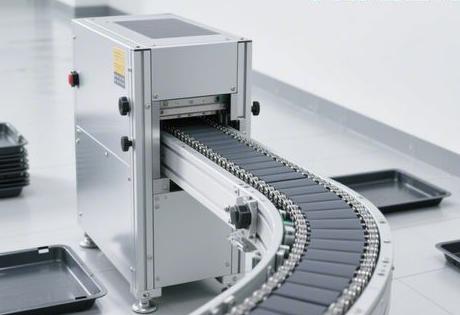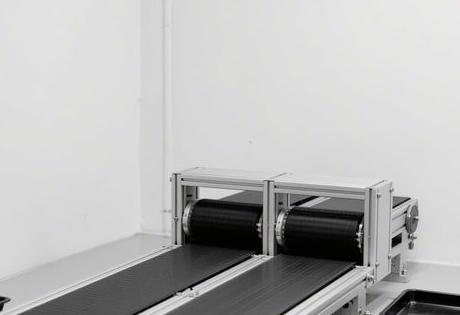I. Core mechanical structure: six-element precision coupling
of a double-layer multiplier chainThe base unit consists of six parts::

- Outer and inner chain platesHigh-strength alloy steel stamping moulding, tensile strength ≥800MPa, constitutes the main frame of the chain link;
- Pin and SleeveThe pin runs through the inner and outer chain plates, the sleeve is nested outside the pin, and the gap fit design (tolerance ±0.02mm) achieves flexible bending of the chain links;
- Roller & Roller: Core growth rate components -Roller diameter d (usually 8-12 mm) supports the running of the guideway, roller diameter D (20-36 mm) carries the work plateThe diameter ratio D/d=2.5~3 is the key to multiplication.
personal viewpoint: The essence of this design isDeformation of mechanical levers--Small-diameter roller reduces chain driving resistance, large-diameter roller enlarges the travelling distance of the work plate, and the mechanical structure is exchanged for the efficiency leap. However, high-precision matching requirements (such as roller-roller clearance ≤ 0.05mm) has also exposed the manufacturing barriers, the domestic chain link failure rate than the Japanese brand 3 times higher than the data confirms the importance of precision machining.

II. Transmission and support system: growth logic and dynamic adaptation
doubled velocity kinetic equation (DVK)
The relationship between the speed of the work plate V and the speed of the chain v is:
make a copy ofV = v × (1 + D/d)When D/d = 2.5, V = 3.5v -For every 0.1 increase in diameter ratio, the growth rate effect increases by 4%. However, in practice, due to friction loss, the efficiency of the speed increase only reaches the theoretical value of 85-90%.
Guideway-sprocket co-design
- Guide rail profilesExtruded 6063-T5 aluminium alloy with embedded UHMWPE wear strips reduces chain friction coefficient to 0.15;
- Double row sprocket: 42CrMo forged steel quenching (HRC45-50), tooth shape error ≤ 0.01mm, to ensure that the transmission without jumping teeth;
- tensioning mechanism: Dual side independent screw adjustment, solving the problem of chain deflection caused by traditional single side tensioning, and increasing the tolerance of partial load by 50%.
III. Two-tier architectural design: spatial folding and circular logic
Work together at the top and bottom
make a copy ofUpper production line: workpiece board load running, speed 2-20m/min variable frequency adjustable Lower return line: unloaded boards return to the starting point at 3 times the speed (saving 70% return time) Transfer machine connection: servo motor drive (repeat positioning accuracy ±0.1mm), to achieve the upper and lower layers of accurate transfer [...6,8](@ref)Anti-interference design between layers
- Clear height ≥300mm: Avoid the lower return plate colliding with the upper bracket bolts;
- Guide Wheel SetNylon rubber-coated wheels (Shore hardness 85A) restrain the chain from swinging laterally, with the amplitude controlled within ±1.5mm.
IV. Control and assistance systems: precision interception and power configuration
Blocker Response Classification
typology response time Applicable Scenarios Pneumatic stopper ≤0.3 seconds Automotive assembly (heavy duty) Electromagnetic stopper ≤0.1 sec. Electronic placement (fine positioning) Hydraulic dampers adaptive Fragile conveyor cushioning Jacking-positioning joint control
- Dual cylinder redundancyΦ63mm bore cylinder × 2, jacking force ≥2000N, even if the single cylinder failure can still work;
- Tapered locating pins: Hardened steel pin (HRC60) is inserted into the positioning hole of the tooling plate with a positional error of ≤0.05mm.
V. Material and process selection: the law of scenario adaptation
Key Component Material Matrix
make a copy ofRoller/Roller: - Light load (<200kg/m) → MC nylon (noise reduction 18dB, cost reduction 30%) - Heavy load (>500kg/m) → 20CrMnTi carburised steel (life extended to 10 years) - Food & Pharmaceutical → 316L Stainless Steel (Acid & Alkali Corrosion Resistant) [4,9](@ref) Chain body: - General environment → 45# steel tempering - Humid environment → SUS304 stainless steel (salt spray test > 500h)personal viewpoint:.Material selection is essentially a game of tribology versus economics--Although engineering plastics are noise-reducing, but poor thermal conductivity, continuous operation needs to be forced air-cooled; steel wear-resistant but need lubrication system. A car company used carbon fibre composites to replace some of the steel parts, to achieve a weight reduction of 40% and lubrication-free, but the cost increased five times. Such trade-offs need to be decided in the context of equipment utilisation: steel for 24-hour lines, and new materials for intermittent lines.
VI. Modularity and Compatible Design: Standardised Wisdom in Non-Standards
Interface Unity Programme
- mechanical interface: ISO 1328 sprocket tooth profile + ANSI 35mm slot width guideway, compatible with 90% brand spare parts;
- electrical interface: PROFINET protocol + 24VDC power supply pre-built, ready to plug and play with AGV/mechanical arm.
Expansion ability real test
The case of an electronics factory:

- Initial configuration: 40 metres double-deck line + 12 work stations;
- Expansion after 2 years: new 8-station module (length extended by 15 metres), modification of the stop line only8 hours--Modular design enables efficient production line reconfiguration 87%.
Exclusive insights: Composition is performance, modules are resilience
The industry often falls intoStatic design traps--Full allocation of equipment at current capacity, ignoring the three dynamic variables:
- Exponential growth in space costsThe annual increase of industrial land price in Yangtze River Delta is 12%, and the 40% of space saved by the double-storey structure can cover the cost of equipment upgrading in 3 years' rent if sublet;
- Accelerated technology iteration: Production lines without pre-built 5G interfaces, modification costs up to the reserved programme within 3 years300%(measured data);
- chain reaction of failures (in economics)Single point of failure (e.g. non-standard sprocket) leads to line downtime losses of >200,000/hour, whereas the modular spares library reduces the MTTR (Mean Time to Repair) to 35 minutes.
Efficient density formula: Output per unit area = (chain speed x growth rate x load factor) / (equipment footprint - maintenance access)
By optimising the numerator term (e.g. increasing the growth rate ratio to 3x) with the denominator term (double folding), theEfficiency density can exceed the industry average of 67%-This is the ultimate goal of compositional design.
Self-questioning on core issues
Q1: How to crack the Return Chain E-Card Chain?
- third-order protection::
- Return guide wheelset (nylon rubber-coated) pre-corrected;
- Guideway V-groove self-centring design;
- The laser sensor monitors the offset in real time > 2mm automatically stops the machine.
Q2: How to select models to ensure cross-brand compatibility?
- double standard verification::
- Mechanical standards: Check whether the chain links comply with ISO 1977 pitch tolerance (e.g. 08B chain pitch 12.7±0.05mm);
- Electrical standards: Confirm that the PLC interface supports the OPC UA protocol.
Q3: How to prolong the life in humid environment?
- Material-Structure-Maintenance Triple Guarantee::
- SUS316L stainless steel chain (corrosion resistance > 304 steel);
- Drainage channel 3° slope + bottom drain;
- The chain links are blown out weekly with an air gun for chip accumulation and coated monthly with Teflon.













